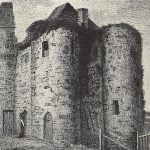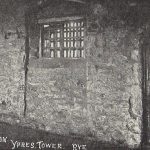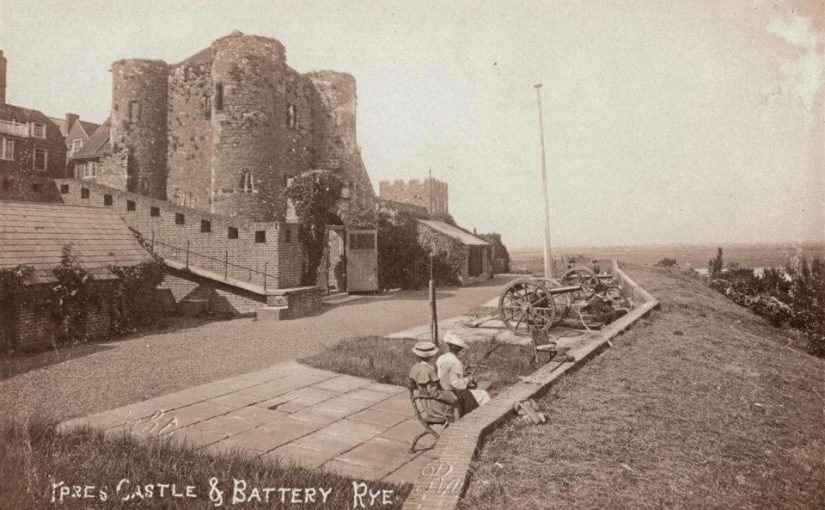BY ARTHUR WOODGATE
It seems to me that where the sea lapped the bottom of the cliff at the Green Steps, where Colebrooks stood 400 years later.
The previous tenants of the ‘Ginger Beer’ factory site was one of Rye’s famous shipyards. Shipbuilding moved on many areas at the southern foot of the town as the sea receded.
The Green Steps are still there and in service, connecting The Strand and Watchbell Street where the Lookout is situated. Baddings Lane reputedly ran back from the Lookout . Some say that part of the Lane fell from the Cliff into the sea so it may well be that originally it ran the whole way back, through the Gungarden and down to Baddings Gate, which was situated at the bottom of the Ypres Steps.
If I close my eyes and think I can picture that area of town as it was a few hundred years ago.
Rye held a formidable Garrison for many years. As a lad I often wondered why the Gungarden faced two ways. I now realise that England had enemies in more than one country and with the sea surrounding the town, enemies could have approached from many angles. Among the early attackers were the Danes (Vikings) who came from the north.
The Great Storm that changed the course of the River Rother also smashed Baddings Gate and part of the lane which ran beside the cliff. This changed the geometry of Rye and left it much as we know it today.
The land side of the town had a much gentler slope down to the Landgate. The Ypres Castle must have been the heart of the Garrison on the south east corner of the town.
“There is still some mystery about the South East part of the town”.
I quote from J.L. Deacon F.R.H.S. writing in 1927 The Gungarden and Castle always was a mystery to me. I and thousands more Rye children over the years played in the area. I noticed that although the canons faced south towards France, there were arrow slits in the wall facing inland.
England was no t a ll o ne country in the far off days when the arrow slits were built. This area was Anglo- Saxon, in the county of Wessex, with Marcia, a very hostile country, to our North. Marcia was controlled by Danes.
Rye must have been an attractive sight when she was an Island. Winchelsea, a town on the shoreline stood fairy close by until that terrible storm. Winchelsea was lost to the sea completely and a new town, built on the grid-iron system, was constructed on the hill that is now Winchelsea. Higham Hill was the generous gift of Icklesham Parish I am told.
Rye lost a defence gate and large lump of wall and land washed into the sea. Was this the start of the sea’s retreat from the town to a point three miles distant?
Nothing much has been found on the old sea bed, which is now buried under many feet of silt, shingle and earth. All I can remember are two large anchors, still on show in Rye.
Another puzzle to me is the Castle itself. Between one tower and the main wall there is a triangle of brickwork, which looks odd, because the Castle is all stone. It is only small and stands about three feet up from the ground and sloping all the way. As kids we used to jump on it and see who could stay the longest but we slipped off in seconds. If anyone knows what it is I would be glad to know. The whole place has produced puzzles from time to time. Another one concerns the roof of the Towers, were they all sloping roofs or were some of them flat?
The Ypres Tower is well over 800 years old. It was reputedly built in 1135 by the Earl of Kent, William de Ypres. William was also a Sheriff of Sussex and cousin of King Stephen.
The Castle is a beautiful building with four foot thick walls, very strong doors and narrow windows. In 1430 it left full time military service, but subsequent owners had to agree to loan it back to the military in time of War. So was used as a private dwelling during its long life.
It then became a Court House and Prison, where my Great Granfather was jailed for smuggling. He was a member of the great Rye family of Batcheler.
The Police built a new Police Station in Church Square. I remember taking dead bodies into a room that was used as a mortuary and washing them down with a hose-pipe to make it easier for the Undertaker.
I dug out several pictures of the Tower taken in 1927. One had two housewives standing at their castle doors, so it has been used as a dwelling place.
Once it had flat roofs all round but over time, it has all sorts of roofs In no two pictures did I find it roofed alike. One picture of the Castle depicted it with an Oast House type cowl another showed it with a flat roof and in another sported a pitched roof with dormer.
In a future article I hope to say more about the gun garden and Square I knew as a boy.
Rye’s Own January 2013
All articles, photographs and drawings on this web site are World Copyright Protected. No reproduction for publication without prior arrangement. © World Copyright 2017 Cinque Ports Magazines Rye Ltd., Guinea Hall Lodge Sellindge TN25 6EG
